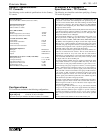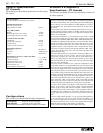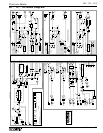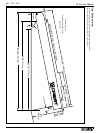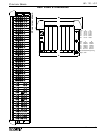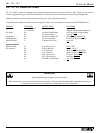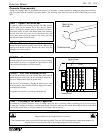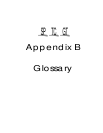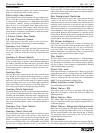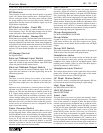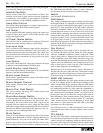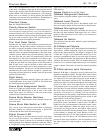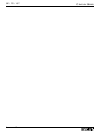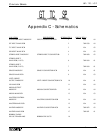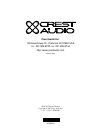
SP / TC / GT
CENTURY SERIES
GLOSSARY
The following glossary explains the features and functions
found on Century Series front of house consoles.
80Hz High Pass Switch
When depressed, this switch attenuates all low frequency con-
tent at a 12db per octave rate referenced to 80Hz. This control
is useful with live microphones, as it helps reduce undesirable
low frequency "rumble", usually is transmitted to the micro-
phone by way of its microphone stand. High quality micro-
phones employ internal shock mounts which lessen this prob-
lem, but it still remains to some degree. If this material is not
removed, the low frequency content tends to make the amplifi-
er and speaker systems work harder.
100mm Fader See Fader
48 Volt Phantom Power
This switch turns on the +48V used to power some micro-
phones. See XLR Microphone Input for more information.
Auxiliary 3•4 Switch
This switch toggles the two upper Aux Send controls between
1,2 and 3,4. With the switch up, the two Send controls feed
Aux 1 and 2. With the switch down, the two controls feed Aux
3 and 4.
Auxiliary 8 Direct Switch
This switch disconnects the Aux 8 level control from the Aux
8 mix bus and instead is used to control the Direct Output of
the channel. Normally the Direct Out jack is post-fader. When
the Aux 8 Direct switch is depressed the Aux 8 level control
assumes output control of the direct out signal. The Aux 8 con-
trol is fed pre-fader.
Auxiliary Bus
The Aux Bus carries signal from the Aux Send controls to the
Aux outputs on the rear panel of the Master Section. A typical
setup would entail using the Aux 1-4 sends for monitor mixes
while Aux 5-8 are used for effect sends. If a separate monitor
mixer were being used, Auxes 1-4 could be used for additional
effect sends. Effects can be returned via the EFX Return sec-
tion of the group modules or through spare input modules.
Auxiliary Mute Switches
The Master Section of the GT consoles have mute switches for
each Aux send. When depressed, this switch mutes the corre-
sponding Aux Send Master. When the mute is engaged no sig-
nal leaves the associated Aux out jack and a red LED illumi-
nates to the left of the switch. These mute switches are active
only if the Aux Mute Master switch on the Master Module is
depressed.
Auxiliary Pre/Post Switch
See Pre/Post Fader Switches
Auxiliary Send Controls
All Century Series consoles employ eight Aux Sends per input
channel which send signal to the Aux Bus. These sends are
controlled via the six level controls on each input module. Aux
Sends 1-4 (orange) are typically used for monitor sends. These
are the two switchable Auxes; see AUXILIARY 3•4 SWITCH
for more info on toggling between 1,2 and 3,4. Aux Sends 5-8
(green) are typically used for effect sends. Each effect return
section has Aux 1-4 Send controls, which could be used for
adding effect return signal to the monitor mix. Internal jumpers
select between pre/post EQ.
Bus Assignment Switches
Wherever these switches occur, they assign the post Pan pot
signals to odd and even mix buses. The Pan pot controls
assignment between odd and even mix buses with extreme left
assigning signal exclusively to the odd mix bus and extreme
right the even mix bus. It is a common practice to assign all
effect return channels to a sub group channel. This enables the
overall amount of effect signal to be controlled from a single
fader location. Between musical numbers, it is possible to turn
off the effects with this group fader or group mute switch or to
vary the amount of overall effect return in reference to the dry
original signals, using the group fader control.
DC Power Indicators
Each Century Series console uses a variety of electrical volt-
ages which are fed to the console from the power supply. The
status of each operating voltage (+20, -20, +48, +24) is indicat-
ed by four LED’s on the master module. If the console ever
behaves abnormally, first check these LED’s to make sure that
the power supply is providing the proper voltages.
Dim Switch
This GT Master Section switch produces a -12dB attenuation
in signal to the local monitor. This feature is useful for tempo-
rary lowering of local monitor levels without actually adjusting
any pots or faders. (Local monitors are automatically dimmed
when Talkback button is pressed.)
Direct Out Jack
Each input module has an unbalanced 1/4 direct out jack. The
output from this jack is post-fader unless the AUXILIARY 8
DIRECT switch is depressed. When this switch is down the
output is controlled by the Aux 8 pot. See AUXILIARY 8
DIRECT for more information on that switch.
Effect Auxiliary Level Control
See AUXILIARY SEND CONTROL
Effect Return EQ
Each effect return section has a two-band fixed EQ. These
High and Low frequency controls are centered at 10kHz and
80Hz respectively.
Effect Return Gain
This control adjusts the gain on the signal returning from the
effect. Use the effect return signal present and peak LED’s to
set the gain properly.
Effect Return Subgroup Assignments
Much like the switches on each input module, these switches
assign the corresponding effect return to any or all subgroups.
The Pan control operates in the same fashion, that is; extreme
left assigning signal exclusively to the odd mix bus and
extreme right the even mix bus.
EQ In Switch
This input module switch, when depressed, inserts the EQ sec-
tion into the signal path and illuminates a green LED to the left
APPENDIX B



